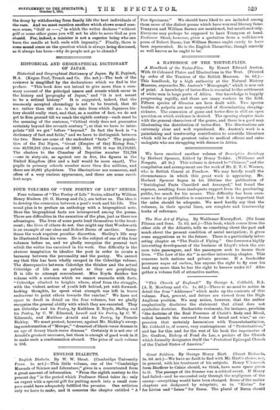HISTORICAL AND GEOGRAPHICAL DICTIONARY OF JAPAN.
Historical and Geographical Dictionary of Japan. By E. Papinot, M.A. (Regan Paul, Trench and Co. 21s. net.)—The task of the reviewer is simplified by the declarations which we find in the preface. "This book does not intend to give more than a sum- mary account of the principal names and events which occur in the history and 'geography of Japan," and "it is not meant to be a critical history." It is suggested, indeed, that the commonly accepted chronology is not to be trusted, that 60 B.C. rather than 660 B.C. is the date from which Japanese his- tory should really start, and that, as a matter of fact, we do not get to firm ground till we reach the eighth century—such must be the meaning of the sentence, "Critical study does not guarantee certainty beyond the seventh century "; so that we have to inter- polate "till we get" before 'beyond." In fact the book is "a dictionary of fact and fable," and we have to distinguish between the two. Here are some of the undoubted "facts." The popula- tion of the Dai Nipon, "Great (Empire of the) Rising Sun," Was 49,758,216 (the census of 1903). In 1876 it was 33,110,825. The electors to the Chamber of Deputies number 751,788 —one in sixty-six, as against one in five, the figures in the United Kingdom (five and a half would be more exact). The pupils in primary schools number more than five millions, and there are 36,661 physicians. The illustrations are numerous, and often of a very curious appearance, and there are some excel- lent maps.






























































 Previous page
Previous page